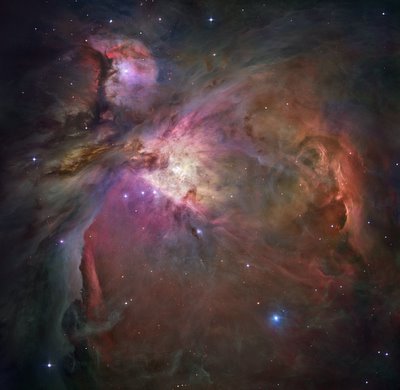
The Orion Nebula has always held a certain fascination to me. Maybe it is the most recognizable constellation in the winter sky. Maybe it is because I actually could see the hunter, one of the only constellations that I truly could see the image that our ancestors saw in the random placement of stars millenia ago. Maybe it is because it has a nebula that hangs off that famous belt of Orion. When I discovered that this nebula is actually a star-birthing factory of sorts, my Star Trek and Star Wars inspired mind just soared. The Orion Nebula was that place that I pictured that I would one day travel to. I wrote stories when I was much younger about benevolent aliens giving me a TARDIS-type ship. I also envisioned that I was The Last Starfighter from that movie. The Orion Nebula was the destination.
Now they are seeing the nebula in even more detail. Thank goodness they put up that Hubble Space Telescope. They have discovered more now that they can see these items clearer, without the interference from our atmosphere. They have discovered 100+ extrasolar planets now.
Maybe the last starfighter is still being looked for. Maybe the Enterprise will one day carry us to these places. Maybe we will one day run into the Battlestar Galactica on its way home, or see those people from a long time ago in a galaxy far, far away. One day. We are just too infantile as a species yet. We are still babies. We are making great strides but we are still in this technological infancy. Maybe my grandchildren will be part of this final frontier.
Credit: NASA and REDORBIT.com
This dramatic image offers a peek inside a cavern of roiling dust and gas where thousands of stars are forming. The image, taken by the Advanced Camera for Surveys (ACS) aboard NASA's Hubble Space Telescope, represents the sharpest view ever taken of this region, called the Orion Nebula. More than 3,000 stars of various sizes appear in this image. Some of them have never been seen in visible light. These stars reside in a dramatic dust-and-gas landscape of plateaus, mountains, and valleys that are reminiscent of the Grand Canyon.
The Orion Nebula is a picture book of star formation, from the massive, young stars that are shaping the nebula to the pillars of dense gas that may be the homes of budding stars. The bright central region is the home of the four heftiest stars in the nebula. The stars are called the Trapezium because they are arranged in a trapezoid pattern. Ultraviolet light unleashed by these stars is carving a cavity in the nebula and disrupting the growth of hundreds of smaller stars. Located near the Trapezium stars are stars still young enough to have disks of material encircling them. These disks are called protoplanetary disks or "proplyds" and are too small to see clearly in this image. The disks are the building blocks of solar systems.
The bright glow at upper left is from M43, a small region being shaped by a massive, young star's ultraviolet light. Astronomers call the region a miniature Orion Nebula because only one star is sculpting the landscape. The Orion Nebula has four such stars. Next to M43 are dense, dark pillars of dust and gas that point toward the Trapezium. These pillars are resisting erosion from the Trapezium's intense ultraviolet light. The glowing region on the right reveals arcs and bubbles formed when stellar winds - streams of charged particles ejected from the Trapezium stars — collide with material.
The faint red stars near the bottom are the myriad brown dwarfs that Hubble spied for the first time in the nebula in visible light. Sometimes called "failed stars," brown dwarfs are cool objects that are too small to be ordinary stars because they cannot sustain nuclear fusion in their cores the way our Sun does. The dark red column, below, left, shows an illuminated edge of the cavity wall.
The Orion Nebula is 1,500 light-years away, the nearest star-forming region to Earth. Astronomers used 520 Hubble images, taken in five colors, to make this picture. They also added ground-based photos to fill out the nebula. The ACS mosaic covers approximately the apparent angular size of the full moon.
The Orion observations were taken between 2004 and 2005.
No comments:
Post a Comment